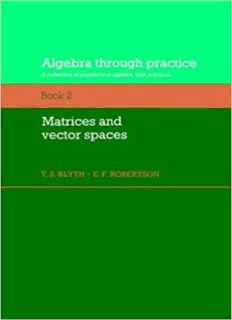
Algebra Through Practice: Volume 2, Matrices and Vector Spaces: A Collection of Problems in Algebra with Solutions PDF
Preview Algebra Through Practice: Volume 2, Matrices and Vector Spaces: A Collection of Problems in Algebra with Solutions
Algebra through practice Book 2: Matrices and vector spaces Algebra through practice A collection of problems in algebra with solutions Book 2 Matrices and vector spaces T.S.BLYTH o E.F.ROBERTSON University of St Andrews The right of the University of Cambridge to print and sell all manner of books was granted by Henry VIII in 1534. The University has printed and published continuously since 1584. CAMBRIDGE UNIVERSITY PRESS Cambridge London New York New Rochelle Melbourne Sydney Published by the Press Syndicate of the University of Cambridge The Pitt Building, Trumpington Street Cambridge CB2 1RP 32 East 57th Street, New York, NY 10022, USA 296 Beaconsfield Parade, Middle Park, Melbourne 3206, Australia © Cambridge University Press 1984 First published 1984 Library of Congress catalogue card number: 83-24013 British Library cataloguing in publication data Blyth, T. S. Algebra through practice. Book 2: Matrices and vector spaces 1. Algebra - Problems, exercises, etc. I. Title II. Robertson, E. F. 512'.0076 QA157 ISBN 0 521 27286 6 Transferred to digital printing 2003 DJ Contents Preface vii Background reference material ix 1: Matrices and linear equations 1 2: Inverses and determinants 8 3: Eigenvalues and diagonalisation 13 4: Vector spaces 18 5: Linear mappings 23 6: Inner product spaces 29 Solutions to Chapter 1 32 Solutions to Chapter 2 45 Solutions to Chapter 3 52 Solutions to Chapter 4 62 Solutions to Chapter 5 73 Solutions to Chapter 6 85 Test paper 1 92 Test paper 2 94 Test paper 3 96 Test paper 4 98 Preface The aim of this series of problem-solvers is to provide a selection of worked examples in algebra designed to supplement undergraduate algebra courses. We have attempted, mainly with the average student in mind, to produce a varied selection of exercises while incorporating a few of a more challenging nature. Although complete solutions are included, it is intended that these should be consulted by readers only after they have attempted the questions. In this way, it is hoped that the student will gain confidence in his or her approach to the art of problem-solving which, after all, is what mathematics is all about. The problems, although arranged in chapters, have not been 'graded' within each chapter so that, if readers cannot do problem n this should not discourage them from attempting problem n + l. A great many of the ideas involved in these problems have been used in examination papers of one sort or another. Some test papers (without solutions) are included at the end of each book; these contain questions based on the topics covered. TSB,EFR St Andrews Background reference material Courses on abstract algebra can be very different in style and content. Likewise, textbooks recommended for these courses vary enormously, not only in notation and exposition but also in their level of sophistication. Here is a list of some major texts that are widely used and to which the reader may refer for background material. The subject matter of these texts covers all six books in the Algebra through practice series, and in some cases a great deal more. For the convenience of the reader there is given below an indication of which parts of which of these texts is more relevant to the appropriate chapters of this book. [1] I. T. Adamson, Introduction to Field Theory, Cambridge University Press, 1982. [2] F. Ayres, Jr, Modern Algebra, Schaum's Outline Series, McGraw-Hill, 1965. [3] D. Burton, A First Course in Rings and Ideals, Addison-Wesley, 1970. [4] P. M. Cohn, Algebra, Vol. I, Wiley, 1982. [5] D. T. Finkbeiner II, Introduction to Matrices and Linear Transformations, Freeman, 1978. [6] R. Go&ement, Algebra, Kershaw, 1983. [7] J. A. Green, Sets and Groups, Routledge and Kegan Paul, 1965. [8] I. N. Herstein, Topics in Algebra, Wiley, 1977. [9] K. Hoffman and R. Kunze, Linear Algebra, Prentice Hall, 1971. [10] S. Lang, Introduction to Linear Algebra, Addison-Wesley, 1970. [11] S. Lipschutz, Linear Algebra, Schaum's Outline Series, McGraw-Hill, 1974. [12] I. D. Macdonald, The Theory of Groups, Oxford University Press, 1968. [13] S. MacLane and G. RiikYioff, Algebra, Macmillan, 1968. [14] N. H. McCoy, Introduction to Modern Algebra, Allyn and Bacon, 1975. [15] J. J. Rotman, The Theory of Groups: An Introduction, Allyn and Bacon, 1973.
Description: